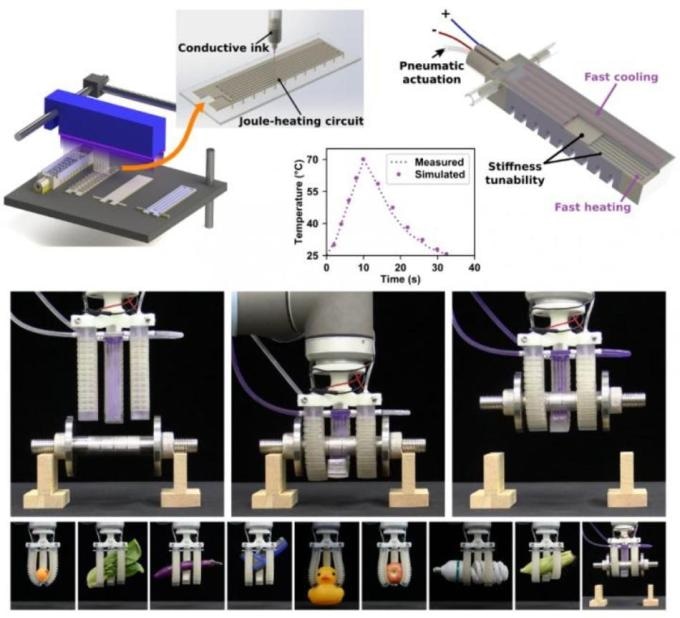Jan 16 2019
Conventional robotic systems that have stiff parts are often known to pose a danger to human operators. In contrast, flourishing robots and soft actuators not only provide superior adaptivity to surroundings but also allow secure, coexisting interaction with humans.
 A Fast-Response, Stiffness-Tunable (FRST) soft actuator is fabricated by hybrid multimaterial 3D printing. Owing to the thermomechanical properties of an embedded shape memory polymer layer, the actuator exhibits flexibility when heated yet high stiffness (120 times its purely elastomeric counterpart) when cooled. Assisted by Joule-heating and fluidic cooling, the heating-cooling cycle is completed within 32 seconds. (Image credit: SUTD)
A Fast-Response, Stiffness-Tunable (FRST) soft actuator is fabricated by hybrid multimaterial 3D printing. Owing to the thermomechanical properties of an embedded shape memory polymer layer, the actuator exhibits flexibility when heated yet high stiffness (120 times its purely elastomeric counterpart) when cooled. Assisted by Joule-heating and fluidic cooling, the heating-cooling cycle is completed within 32 seconds. (Image credit: SUTD)
Conversely, the innate low-stiffness nature of constituent materials, such as silicone rubbers, tends to undermine the competence of such systems in load-bearing tasks.
With regards to stiffness-tunable materials that aid in boosting the load capacity of soft robotic systems without affecting their compliance at the time of robot-object interaction, thermally activated shape memory polymers (SMPs) are considered a potential candidate. These SMPs are compatible with 3D printing and can also reversibly alter the stiffness by two to three orders of magnitude. However, to date, SMP-based soft actuators have been shown to have certain limitations like small deformations, slow responses, and complications in automated fabrications with microfeatures.
At the Singapore University of Technology and Design (SUTD) and Shanghai Jiao Tong University (SJTU), researchers have now proposed a model to use hybrid multimaterial 3D printing and finite-element simulations to design and create fast-response, stiffness-tunable (FRST) soft actuators, which have the potential to complete a softening-stiffening cycle in just 32 seconds.
We combine a commercial inkjet multimaterial 3D printing technology with the direct-ink writing approach to fabricate our fully printed FRST actuator. The stiffness tunability is provided by an embedded SMP layer, and the fast response is enabled by embedded heating and cooling elements.
Qi (Kevin) Ge, Study Co-Lead and Assistant Professor, Science and Math Cluster, Singapore University of Technology and Design.
As a matter of fact, the incorporation of the SMP layer into the actuator body improves its stiffness by as much as 120 times without affecting adaptivity and flexibility. A deformable conductive circuit, which is printed with a silver nanoparticle, stimulates the SMP’s rubbery state through localized Joule-heating. After the actuator is deformed with pressurized air, the SMP is allowed to cool down with coolant fueled through a fluidic channel to lock the geometry.
“The deformed actuator in its stiff state can perform load-carrying tasks, even after releasing the pressurised air. More importantly, a heating-cooling cycle can be completed within about half a minute, which is the fastest rate reported, to our knowledge,” stated Professor Ge.
We have also built computational models to simulate the mechanical and thermal-electrical behaviors of our FRST actuator. Once validated with experiments, the models are used to guide the design of FRST actuator and provide insights into enhancement of load capacity.
Yuan-Fang Zhang, Study Co-First Author and Postdoc Researcher, Singapore University of Technology and Design.
On the whole, the designs of the fluidic microchannel layer and the Joule-heating circuit significantly bring down the time of a heating-cooling cycle to approximately 30 seconds, which considerably improves the viability of the thermally responsive stiffness-tunable soft actuator, making it appropriate for other applications as well.
To showcase the high load capacity and shape adaptivity of our prototype, we have devised a robotic gripper with three FRST actuators that can grasp and lift objects with arbitrary shapes and various weights spanning from less than 10 g to up to 1.5 kg.
Guoying Gu, Study Co-Lead and Professor, Singapore University of Technology and Design.
The study was funded by SUTD’s Digital Manufacturing and Design (DManD) Centre, which is supported by the Singapore National Research Foundation (NRF), Singapore’s National Additive Manufacturing Innovation Cluster (NAMIC), the National Natural Science Foundation of China, and the Science and Technology Commission of Shanghai Municipality.
The study has been reported in Advanced Functional Materials.